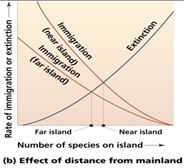Biodiversity and Conservation - Online Test
Q1. Species which suffered a near-extinction from ingesting the carrion of diclofenac-treated cattle is/are:
Answer : Option D
Explaination / Solution:
These include the Asiatic lion, the Bengal tiger, the snow leopard and the Indian white-rumped vulture, which, by ingesting the carrion of diclofenac-laced cattle, nearly went extinct.
Q2. Read the following statements :
a) India is considered as one of the 12 mega diversitycenters of the world.
b) India contributes to a high percentage of global species diversity.
a) India is considered as one of the 12 mega diversitycenters of the world.
b) India contributes to a high percentage of global species diversity.
Answer : Option D
Explaination / Solution:
The megadiverse countries are a group of countries that harbor the majority of Earth's species and high numbers of endemic species. Conservation International identified 17 megadiverse countries in 1998.
India is one of the twelvemega diversity countries of the world with bio-diversity hot spots such as Eastern Himalayaand the Western Ghats,
With only 2.4% of world's land area, India accounts for 7-8% of recorded species of the world. In terms of species richness, India ranks seventh in mammals, ninth in birds and fifth in reptiles.
Q3. Wild animals :
i) Frequently breed in Zoos.
ii) Reproductive capacity is lowered if area of free movement is reduced.
i) Frequently breed in Zoos.
ii) Reproductive capacity is lowered if area of free movement is reduced.
Answer : Option D
Explaination / Solution:
Reproductive capacity of an animals is lowered if area of free movement is reduced. So, wild animals do not breed frequently in Zoos. So, statement i is wrong and ii is correct.
Q4. Surveys and statistical studies have reported that endemic species show
Answer : Option B
Explaination / Solution:
Endemic species are plants and animals that exist only in one geographic region. Species can be endemic to large or small areas of the earth
Endemic species of an ecological region try to maintain same genetic makeup. These species are well suited in particular habitat and shows very less variation in comparison to other species.
Q5. Interpret from the following graph :


Answer : Option D
Explaination / Solution:
Extinction rates are unaffected due to immigration near island and immigration far island. Extinction rate is affected by human interference.
Q6. If a species experiences a 90 percent decline over 10 years (or three generations), would be classified as :
Answer : Option B
Explaination / Solution:
A critically endangered (CR) species is one which has been categorized by the International Union for Conservation of Nature (IUCN) as facing a very high risk of extinction in the wild.
Criteria for critically endangered is an observed, estimated, inferred or suspected population size reduction of ≥ 90% over the last 10 years or three generations, whichever is the longer, where the causes of the reduction are clearly reversible AND understood AND ceased.
Critically endangered species should be protected to avoid extinction.
Q7. Select the group which represents only critically endangered species (as per 2008 red list):
Answer : Option B
Explaination / Solution:
According to red data book 2008, Critically endangered is the highest conservation status animals. The Amur Leopard who has just over 60 individuals left in its population. The Cross River Gorillas are a population between 200 and 300 individuals. Hawksbill Turtle, Leatherback Turtle have all unknown population numbers.
Q8. Which of the following is a vulnerable species (as per 2008 red list):
Answer : Option B
Explaination / Solution:
The IUCN Red List of Threatened Species (also known as the IUCN Red List or Red Data List), founded in 1964, is the world's most comprehensive inventory of the global conservation status of biological species.
Vulnerable species are likely to become endangered unless something changes. Polar bear is likely to become endangered due to climate change. So, polar bear is vulnerable species as per 2008 red book list.
Q9. A category containing those species whose members survive only in captivity or as artificially supported populations far outside their historical geographic range is grouped under:
Answer : Option A
Explaination / Solution:
A taxon known only to survive in cultivation, in captivity or as a naturalized population (or populations) well outside the past range. A taxon is presumed Extinct in the Wild when exhaustive surveys in known and/or expected habitat, at appropriate times (diurnal, seasonal, annual), throughout its historic range have failed to record an individual. Surveys should be over a time frame appropriate to the taxon’s life cycle and life form.
Q10. How many species in the world are facing threat of extinction?
Answer : Option B
Explaination / Solution:
Nearly 700 species have become extinctin recent times and more than 15,500 species (of which > 650 are from India) which includes amphibians, gymnosperms, reptiles, birds and mammals etc. currently face the threat of extinction.
The causes of high extinction rates at present include habitat (particularly forests) lossand fragmentation, over-exploitation, biological invasions andco-extinctions.
